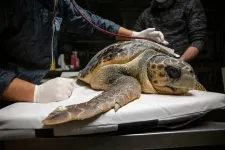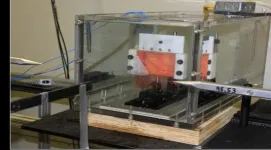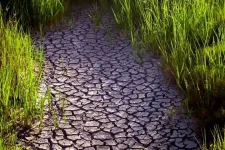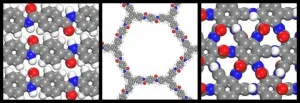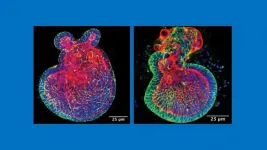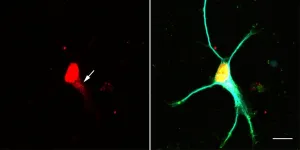Heavy rain affects object detection by autonomous vehicle LiDAR sensors
2021-02-25
(Press-News.org) Future fully autonomous vehicles will rely on sensors to operate, one type of these sensors is LiDAR
LiDAR sensor's effectiveness in detecting objects at a distance in heavy rain decreases, researchers from WMG, University of Warwick have found
Researchers used the WMG 3xD simulator to test the sensor detection of objects in rain, simulating real world roads and weather
High level autonomous vehicles (AVs) are promised by Original Equipment Manufacturers (OEMs) and technology companies to improve road safety as well as bringing economical and societal benefits to us all.
All high-level AVs rely heavily on sensors, and in the paper, 'Realistic LiDAR with Noise Model for Real-Tim Testing of Automated Vehicles in a Virtual Environment', published in the IEEE Sensors Journal, researchers from the Intelligent Vehicles Group at WMG, University of Warwick have specifically simulated and evaluated the performance of LiDAR sensors in rain.
Using the WMG 3xD simulator, researchers tested an autonomous vehicle's LiDAR sensors in different intensities of rain, driving around a simulation of real roads in and around Coventry. The simulator is a key part of testing autonomous vehicles, as they have to have been on several million miles of road, this therefore means that they can be tested in a safe environment that is the same as a real road.
LiDAR sensors work by emitting numerous narrow beams of near-infrared light with circular/elliptical cross sections, these can reflect off objects in their trajectories and return to the detector of the LiDAR sensor.
One of the issues of LiDAR sensors is the degradation of its performance in rain. If a LiDAR beam intersects with a raindrop at a short distance from the transmitter, the raindrop can reflect enough of the beam back to the receiver, therefore detecting the raindrop as an object. The droplets can also absorb some of the emitted light, degrading the range of performance for the sensors.
Using different probabilistic rain models (none, to different intensities) researchers made it 'rain' the WMG 3XD simulator, and measured the LiDAR sensor's responses to the rain, making a record of false positive and false negative detections.
They found that as the rain intensity increased it became more difficult for the sensors to detect objects. In a short range from the vehicle (up to 50m), several rain drops were erroneously detected. However in a medium range, (50m-100m) this had decreased, but as rainfall increased to up to 50mm per hour, the sensors detection of objects decreased in conjunction with a longer range in distance.
Dr Valentina Donzella, from WMG, University of Warwick comments:
"Ultimately we have confirmed that the detection of objects is hindered to LiDAR sensors the heavier the rain and the further away they are, this means that future research will have to investigate how to ensure LiDAR sensors can still detect objects sufficiently in noisy environment.
"The developed real-time sensor and noise models will help to further investigate these aspects, and may also inform autonomous vehicles manufacturers' design choices, as more than one type of sensor will be needed to ensure the vehicle can detect objects in heavy rain."
INFORMATION:
[Attachments] See images for this press release:

ELSE PRESS RELEASES FROM THIS DATE:
2021-02-25
PITTSBURGH--Babies whose births were depicted in Bollywood films from the 1950s and 60s were more often than not boys; in today's films, boy and girl newborns are about evenly split. In the 50s and 60s, dowries were socially acceptable; today, not so much. And Bollywood's conception of beauty has remained consistent through the years: beautiful women have fair skin.
Fans and critics of Bollywood -- the popular name for a $2.1 billion film industry centered in Mumbai, India -- might have some inkling of all this, particularly as movies often reflect changes in the culture. But these insights came via an automated computer analysis designed by Carnegie Mellon University computer ...
2021-02-25
Sea turtles are witnesses and victims of the high level of plastic pollution of the Adriatic Sea. A group of researchers at the University of Bologna analysed 45 turtles hospitalised at Fondazione Cetacea in Riccione and found plastic debris in their faeces. Besides confirming the role of turtles as ideal sentinels to monitor plastic pollution in the sea, the results of their analysis - published in the journal Frontiers of Marine Medicine - crucially show how the plastic debris in their intestines can dangerously alter their microbiota, eventually compromising their health.
"The results ...
2021-02-25
RESEARCH TRIANGLE PARK, N.C. -- Research shows that Soldiers exposed to shockwaves from military explosives are at a higher risk for developing Alzheimer's disease -- even those that don't have traumatic brain injuries from those blasts. A new Army-funded study identifies how those blasts affect the brain.
Researchers at the University of North Carolina at Pembroke in collaboration with the U.S. Army Combat Capabilities Development Command, now known as DEVCOM, the Army Research Laboratory, and the National Institutes of Health found that the mystery behind blast-induced neurological ...
2021-02-25
UNIVERSITY PARK, Pa. -- The optimal timeframe for donating convalescent plasma for use in COVID-19 immunotherapy, which was given emergency use authorization by the Food and Drug Administration in August 2020, is within 60 days of the onset of symptoms, according to a new Penn State-led study. The research also reveals that the ideal convalescent plasma donor is a recovered COVID-19 patient who is older than 30 and whose illness had been severe.
"Millions of individuals worldwide have recovered from COVID-19 and may be eligible for participation in convalescent plasma donor programs," said Vivek Kapur, professor of microbiology and infectious diseases, Penn State. "Our findings enable identification ...
2021-02-25
CHAMPAIGN, Ill. --Many climate models focus on scenarios decades into the future, making their outcomes seem unreliable and problematic for decision-making in the immediate future. In a proactive move, researchers are using short-term forecasts to stress the urgency of drought risk in the United States and inform policymakers' actions now.
A new study led by University of Illinois Urbana-Champaign civil and environmental engineering professor Ximing Cai examines how drought propagates through climate, hydrological, ecological and social systems throughout different U.S. regions. The results are published in the journal Geophysical Research Letters.
"The same amount of precipitation, or the lack of thereof, in one region could have very different impacts on the hydrologic ...
2021-02-25
Black men and women, as well as adolescent boys and girls, may react differently to perceived racial discrimination, with Black women and girls engaging in more exercise and better eating habits than Black men and boys when faced with discrimination, according to research published by the American Psychological Association.
"In this study, Black women and girls didn't just survive in the face of racism, they actually responded in a positive manner, in terms of their health behavior," said lead researcher Frederick Gibbons, PhD, with the University of Connecticut. "This gives us some hope that despite the spike in racism across the country, some people are finding healthy ways to cope." ...
2021-02-25
ADELPHI, Md. -- Army researchers reached a breakthrough in the nascent science of two-dimensional polymers thanks to a collaborative program that enlists the help of lead scientists and engineers across academia known as joint faculty appointments.
Researchers from the U.S. Army Combat Capabilities Development Command, now known as DEVCOM, Army Research Laboratory partnered with Prof. Steve Lustig, a joint faculty appointment at Northeastern University, to accelerate the development of 2D polymers for military applications.
The collaboration with ARL Northeast led to a groundbreaking study published in the peer-reviewed scientific journal Macromolecules. Editors featured the research in a cover article.
"2D polymers have been studied very seriously from a synthetic ...
2021-02-25
Researchers have developed a tool to identify security and privacy risks associated with Covid-19 contact tracing apps.
COVIDGuardian, the first automated security and privacy assessment tool, tests contact tracing apps for potential threats such as malware, embedded trackers and private information leakage.
Using the COVIDGuardian tool, cybersecurity experts assessed 40 Covid-19 contact tracing apps that have been employed worldwide for potential privacy and security threats. Their findings include that:
72.5 per cent of the apps use at least one insecure cryptographic ...
2021-02-25
Medical researchers have long understood that a pregnant mother's diet has a profound impact on her developing fetus's immune system and that babies -- especially those born prematurely -- who are fed breast milk have a more robust ability to fight disease, suggesting that even after childbirth, a mother's diet matters. However, the biological mechanisms underlying these connections have remained unclear.
Now, in a study published Feb. 15, 2021, in the journal Nature Communications, a Johns Hopkins Medicine research team reports that pregnant mice fed a diet rich in a molecule found abundantly in cruciferous vegetables -- such as broccoli, Brussels sprouts and cauliflower -- gave birth to pups with stronger protection against necrotizing enterocolitis (NEC). ...
2021-02-25
Neurodegenerative diseases, such as various forms of senile dementia or amyotrophic lateral sclerosis (ALS), have one thing in common: large amounts of certain RNA-protein complexes (snRNPs) are produced and deposited in the nerve cells of those affected - and this hinders the function of the cells. The overproduction is possibly caused by a malfunction in the assembly of the protein complexes.
How the production of these protein complexes is regulated was unknown until now. Researchers from Martinsried and Würzburg in Bavaria, Germany, have solved the puzzle and now report on it in the open access journal Nature Communications. They describe in detail a signaling pathway that prevents the overproduction of snRNPs when they are not needed. The results should ...
LAST 30 PRESS RELEASES:
[Press-News.org] Heavy rain affects object detection by autonomous vehicle LiDAR sensors

